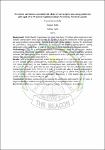| dc.identifier.citation | Amony, S.S., Udho, S., and Apili, F. (2023). Prevalence and factors associated with Modern Contraceptive use among adolescent girls aged 15 to 19 years in Pagirinya Refugee Settlement, Northern Uganda | en_US |
| dc.description.abstract | Background: World Health Organization revealed that about 23 million adolescents have their
modern contraceptive needs not yet met. In Uganda, 12% of the adolescents in this age group
are using modern contraceptives, with the lowest odds in the northern region. We determined
the prevalence and factors associated to utilization of modern contraceptives among
adolescents’ girls aged 15 to 19 years in Pagirinya Refugee Settlement, Adjumani district.
Methodology: This is a community-based cross-sectional study to investigate modern
contraceptive use among adolescents’ girls aged 15 to 19 years. Using probability sampling
methods, 400 participants were selected. Questionnaires were pretested and data collectors
trained. Data was analyzed using STATA.
Results: 60% of the participants fell within the age range of 15-17 years, and all were females.
51.75% utilized modern contraceptives, multivariate analysis showed that Muslim girls were
2.45 times more likely to use modern contraceptives than protestants (AOR=2.45, 95%
CI=1.22-4.91, p=0.012). girls who had not been pregnant were 76% less likely to use modern
contraceptives (AOR=0.24, 95% CI=0.15-0.41, p<0.0010. the odds of modern contraceptive
use reduced by 58% for those unaware of modern contraceptives (AOR=0.42, 95% CI=0.24-
0.71, p=0.001), 62% for those uncomfortable discussing it with health care providers
(AOR=0.38, 95% CI=0.22-0.64, p<0.001).
Conclusions: Modern contraceptive use among the adolescent girls aged 15 to 19 years in
Pagirinya Refugee settlement was significantly high compared to other studies.
Keywords: Adolescents, modern contraceptive, refugee, determinants, prevalence. | en_US |

